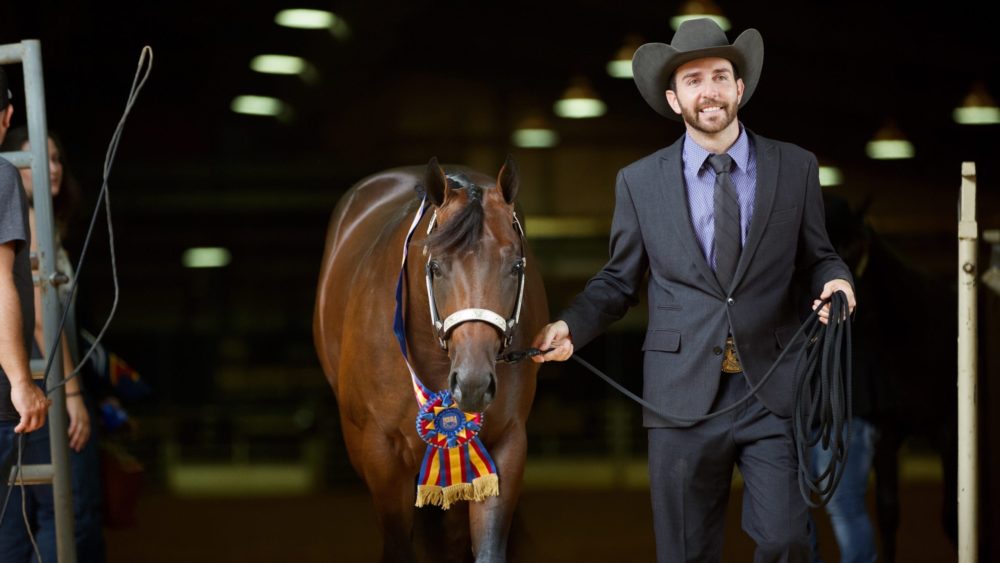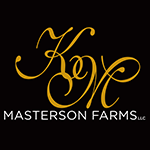In the final installment of our “Training the Eye” series, we will focus on the traits to look for when selecting a future all-around contender to increase your chances for success under saddle.
Again, proven horses are priced high, which can make it difficult for many amateurs to afford something that’s already found success as an all-around horse. Therefore, these buyers are often in a position where they need to find a prospect and hope it’s the one to make their dreams come true.
We spoke with multiple champion yearling trainer Anthony Leier to get his advice for what to look for in a young all-around prospect in order to increase your chances of success at a high level.
In case you missed them, be sure to check out Part I of this series where leading breeder Debbi Trubee provided her tips for selecting a western pleasure prospect and Part 2 where champion trainer Jamie English shared her tips for selecting a top hunter prospect.
Conformation
As with all of our experts, Leier first looks to the animal’s conformation to get an idea of whether they are built for success.
 “First and foremost, I like to see an animal that is really strong across their back,” Leier explains. “To have success in the all–around, you need an individual with a lot of self-carriage and stamina. Therefore, they need a strong topline to stay correct across events.”
“First and foremost, I like to see an animal that is really strong across their back,” Leier explains. “To have success in the all–around, you need an individual with a lot of self-carriage and stamina. Therefore, they need a strong topline to stay correct across events.”
To Leier, a “strong topline” is defined as an animal with a nice, short back that grows fairly evenly without the animal being too downhill.
Leier says once he looks at the animals back, he moves forward to their withers and neck. “I like to look at how their neck ties in – which is essentially how it comes out of the shoulder and wither. You don’t want the neck to tie too low down the chest or too upright from the wither.”
Additionally, Leier likes to see a “big, strong hip.” He explains, “The horse’s hind end is their motor and they need a strong motor to drive from behind and a strong shoulder to lift and get out of the way so their front leg can come out fancy.”
Ultimately, “In order to move correctly across multiple classes and disciplines, you need a strong animal that is physically capable of maintaining the right frame to find success.”
Size
Similar to selecting a hunter under saddle candidate, size does matter (to an extent) in the all-around. Leier says that his clients that shop for an all-around contender are typically looking for something that will finish around 15.3 – 16.2h.
 “Adult height can be so hard to predict as horses grow at different rates,” Leier admits. “Often, I will look to the siblings and what the dam has thrown in the past to get a best estimate of a baby’s future height.”
“Adult height can be so hard to predict as horses grow at different rates,” Leier admits. “Often, I will look to the siblings and what the dam has thrown in the past to get a best estimate of a baby’s future height.”
Generally speaking, Leier can get a good idea in their yearling year whether they will have the height to be considered an “ideal” candidate for the all-around. “Earlier in their yearling year, I like to see them anywhere from 14.2-14.3h. Then, toward the end of their yearling year, I like them to be at least 15.1h as I can expect a few more inches of growth after that.”
Movement
Movement for an all-around contender is a little more amorphous. Generally, there are few horses that can win a western pleasure event and turn around and win the hunter under saddle – the horses are so specialized now. Therefore, Leier will look for traits that have potential across several disciplines and classes to hedge his bets the horse will be a contender in many areas.
 “You don’t want a horse that is too tight-strided. While that is certainly a benefit in the western pleasure pen, it can be a disadvantage in the pattern or in English classes. So, you want to find a horse that can slow down and jog or lope, but that has the capability to stride out and step over logs or long trot.”
“You don’t want a horse that is too tight-strided. While that is certainly a benefit in the western pleasure pen, it can be a disadvantage in the pattern or in English classes. So, you want to find a horse that can slow down and jog or lope, but that has the capability to stride out and step over logs or long trot.”
Leier says that some of the traits that make for a strong all-around horse are less desirable for a pleasure horse. “Everyone loves something with that pretty, flat front leg. However, when it comes to all-around, they will eventually have more knee due to the need to execute tight turns and step over logs without rolling them.”
In order to accommodate for the demands of the all-around without sacrificing quality of movement, Leier strives to “look for something with self-carriage and lift from the shoulder. This will allow them to lift up to get over and around obstacles without compensating with too much knee.”
 “I also want to see something that can hold the ground when they are loping across the pasture as a baby. I don’t want to see an animal that skips across the ground. Instead, they need some stay in order to be slow-legged for the pleasure events while also having the ability to hold their hind down and get into positions for the tight turns in pattern classes.”
“I also want to see something that can hold the ground when they are loping across the pasture as a baby. I don’t want to see an animal that skips across the ground. Instead, they need some stay in order to be slow-legged for the pleasure events while also having the ability to hold their hind down and get into positions for the tight turns in pattern classes.”
Leier laughs that many amateurs seem to be deceived by the babies that want to “sniff the dirt” and move with a super low head carriage. While it may demonstrate a neck that naturally wants to hang, Leier likes his longe liners to “be up a little in their head set, because they will be more upright in the shoulder to allow the front leg to reach and the toe to point.”
“I don’t think you can truly tell a baby’s head carriage until they really get into training. So, don’t pay too much mind to what they are doing in the field,” Leier warns. “Look at whether the neck is built to allow a lower head set.”
Pedigree
Pedigree is always up for discussion when buying babies and, as a breeder himself, Leier takes this seriously.
 However, Leier does not believe that people should specifically aim to breed for an all-around horse. “I believe you should breed for a western pleasure or a hunt seat horse. If you are breeding for an all-arounder, it is likely that the horse will take a lot more time to mature into their event. Breed for a horse that can excel in a specific event, but is athletic enough to do more than one event as they mature.”
However, Leier does not believe that people should specifically aim to breed for an all-around horse. “I believe you should breed for a western pleasure or a hunt seat horse. If you are breeding for an all-arounder, it is likely that the horse will take a lot more time to mature into their event. Breed for a horse that can excel in a specific event, but is athletic enough to do more than one event as they mature.”
Essentially, Leier aims to breed horses that will excel in the pleasure, but are athletic and intelligent enough to do trail or western riding. Or, conversely, he will aim to breed a hunt seat horse that is smart enough to show in the patterns or strong enough to hold up to jumping.
So, when looking into pedigrees, look at horses that are versatile within their discipline and then evaluate the animal in front of you to determine their individual strengths and whether those will meet your needs.
Mind
Finally, Leier has an interesting take when it comes to what to look for in a future multi-discipline prospect. “It’s difficult to explain,” Leier chuckles, “But I don’t necessarily want a horse that is ‘too good-minded.’”
 He explains further, “When you have a horse that’s super quiet, they also tend to be a bit dull. Then, when you get to riding these horses, they struggle with really putting in work and effort. I believe this is because they don’t have any grit due to being so quiet.”
He explains further, “When you have a horse that’s super quiet, they also tend to be a bit dull. Then, when you get to riding these horses, they struggle with really putting in work and effort. I believe this is because they don’t have any grit due to being so quiet.”
“In my experience, the super quiet babies without that fire don’t make great riders because they simply don’t have enough try. I honestly believe there is a fine line between a great-minded horse and a lazy one.”
Leier advises, “You want an animal that will respond to training. You want something that wants to be busy and work and please, not something that just doesn’t care one way or the other.”
Therefore, Leier recommends buyers “look for a prospect with enough fire in their belly to try, without overpowering their talent by being too spirited. The best ones seem to have a little bit of ‘personality’ to them.”
Be sure to check out Part 1 of our “Training the Eye” series with Debbi Trubee and western pleasure prospects and Part 2 with Jamie English and hunter under saddle prospects.








